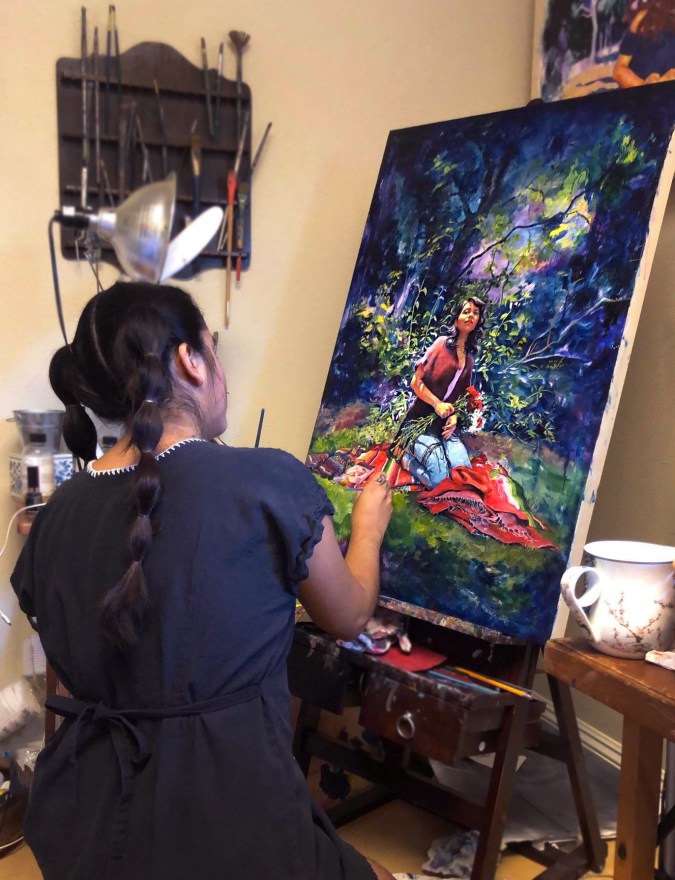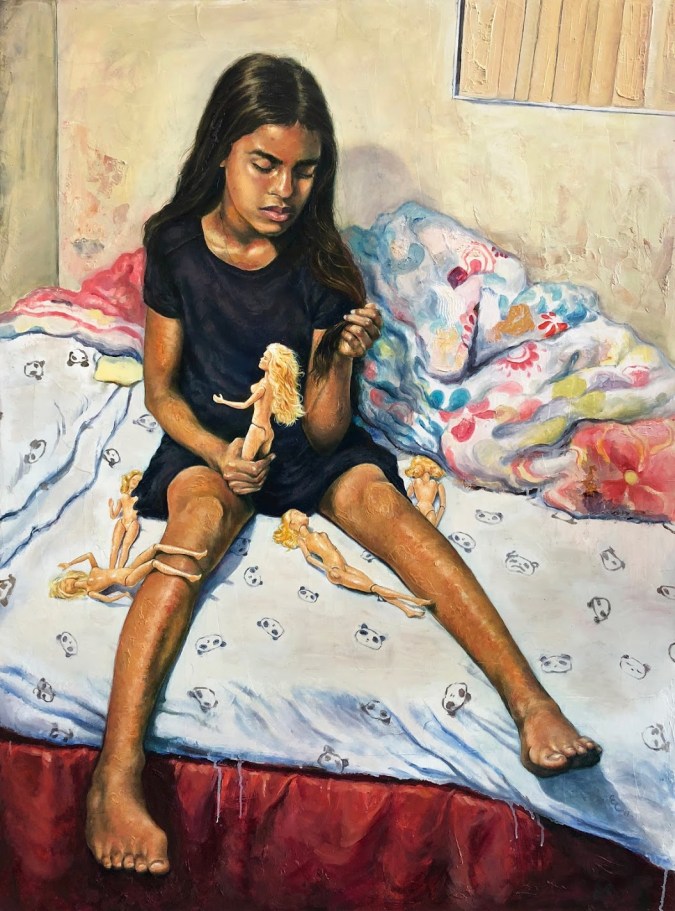In 2019, artist Emilia Cruz received a commission quite unlike the usual: she needed to create portraits of fictional characters. The Simi Valley, California-based artist normally paints portraits depicting women of color surrounded by nature or surreal elements. For this commission, she would keep her vibrant, lush style—but portray a few characters. The job was for the Netflix series Gentefied.
The show’s co-creator, Linda Yvette Chávez, first reached out to Cruz on Instagram, where the artist currently shares her artworks and process to more than 26,000 followers. In the series, Ana Morales (played by Karrie Martin) is an artist trying to make a full-time career out of her passion. She lives at home with her mom and younger sister, often clashing with the former in her pursuit of a creative life. Cruz’s paintings became the work that Ana paints in the series.
After speaking with Chávez and co-creator Marvin Lemus, Cruz got to work on five commissions with a tight deadline energizing her.
“I was barely sleeping,” Cruz tells Remezcla. “And I remember just like turning in the last piece and being like ‘oh my god okay I’m going to go crash now’… I was just so tired, but it was worth it.”

Before her increased Instagram following and display of her artwork on a major streaming service, Cruz says she was working two jobs while enrolled in—and then dropping out of—community college. During a visit to the ArtCenter College of Design, Cruz fell in love with the campus and started putting her portfolio together. Now she’s studying there and teaching classes to young artists ages three to 12 at Plaza de la Raza (sadly, in-person classes are currently on hiatus due to COVID-19).
Even though she rarely saw artists or subjects that looked like her growing up, Cruz often turned to art as an escape. It often felt like “a second language,” she says.
“People painted an artist as [if] you could only be successful if you were at a certain point,” says Cruz. “You read about these artists and none of them seem familiar, and I never thought I could get to that point.”


The ArtCenter helped her hone a work ethic that would lead her to gallery shows and, eventually, the Gentefied gig. Cruz says it was important for her to glean all she could from school, but also connect with living artists around her to see what careers they made out of their own creative drive.
On social media, she slowly started to share more vulnerable stories about her childhood and the inspiration behind her artworks. In “Am I Too Dark,” Cruz depicts her younger sister sitting on a bed with a doll in her hand and others strewn around her. She holds a lock of her hair and looks thoughtful and dejected. The painting expresses Cruz’s own struggles growing up as a woman of color.
“I opened up about my story, about appearance and colorism and all that,” says Cruz. “And that was the first time I really just let it all out. And I started getting messages from other people telling me their experiences and how they also had trouble talking about it—or [how] to this day, they’re still trying to heal from it.”

Healing plays a big role in Cruz’s work, and the surreal elements of her compositions tie into the theme. Some of her works depict women of color sitting together in a group or holding one another. They often sit amongst nature. Spirals of color—personified hues of their inner thoughts and emotions—float around them.
Sometimes the pieces take on a darker tone, though, illuminated by moonlight from behind or showing a figure that resembles death sitting nearby. Cruz also purposefully chooses the plants she includes to reference “the concept of growth and how everyone does it at their own time.” In certain compositions, she paints plants that grow more slowly, while in others she depicts those that grow faster.
Her paintings’ environments largely focus on the outdoors, a space that Cruz sees as a balm for many women of color.


“We should all be able to go and experience nature and just immerse ourselves with it,” says Cruz. “It’s the most healing thing you can do. I’m often brought back to that… Those are the places for me that are the most safe and healing, and I always want to place my subjects in that kind of environment.”
Cruz completed a number of pieces for Gentefied but the one that gets revealed at the climax of the series during its season finale depicts the matriarch of the family, Mama Fina. Cruz had little information on the character so she started to make up her own story about the figure in order to “bring in that spirit and that energy that the piece needed for it to work.”
In that final episode, Ana’s mom seems to finally acknowledge her dedication for the craft at her daughter’s exhibit. However, it’s a loaded scene because the opportunity to do so comes from an art patron who then turns out to be at odds with her values. A big reveal happens during this episode and Ana storms out.

Cruz’s worlds collided in the space where that scene took place. Prior to shooting, the co-creators called to say they wanted her to see the solo show at Plaza de la Raza where they were setting up. Once she saw the final scene, it resonated with Cruz on a personal level. The 27-year-old is lucky to have supportive parents but admits it took some time for them to see she was truly invested.
At the time of writing, Cruz doesn’t know if her artwork will be featured in season two but she says that no matter she’s “still happy to have even been part of the beginning.” In the meantime, Cruz is adjusting to the “new normal” of lockdown by doing virtual classes.
“The response shocked me [seeing] how many people wanted to join in,” Cruz says.”It was really cool because you got to see all different ages. A lot of people told me they’ve never even drawn before.” 70% of the proceeds from the donation-based workshop went to an Undocu Mutual Fundraiser, organized by clothing store Gata Salvaje.
She says that in the current atmosphere, even virtually meeting people who want to create art feels invaluable.
“It’s nice to know that there’s little things I can do,” Cruz says.
In light of the Black Lives Matter movement and protests, Cruz has also used her Instagram to share relevant resources.
Whether her artwork makes it on to another season of television or not, Cruz is continually making connections through her people who relate to the artwork and those that want to tell their own stories.




